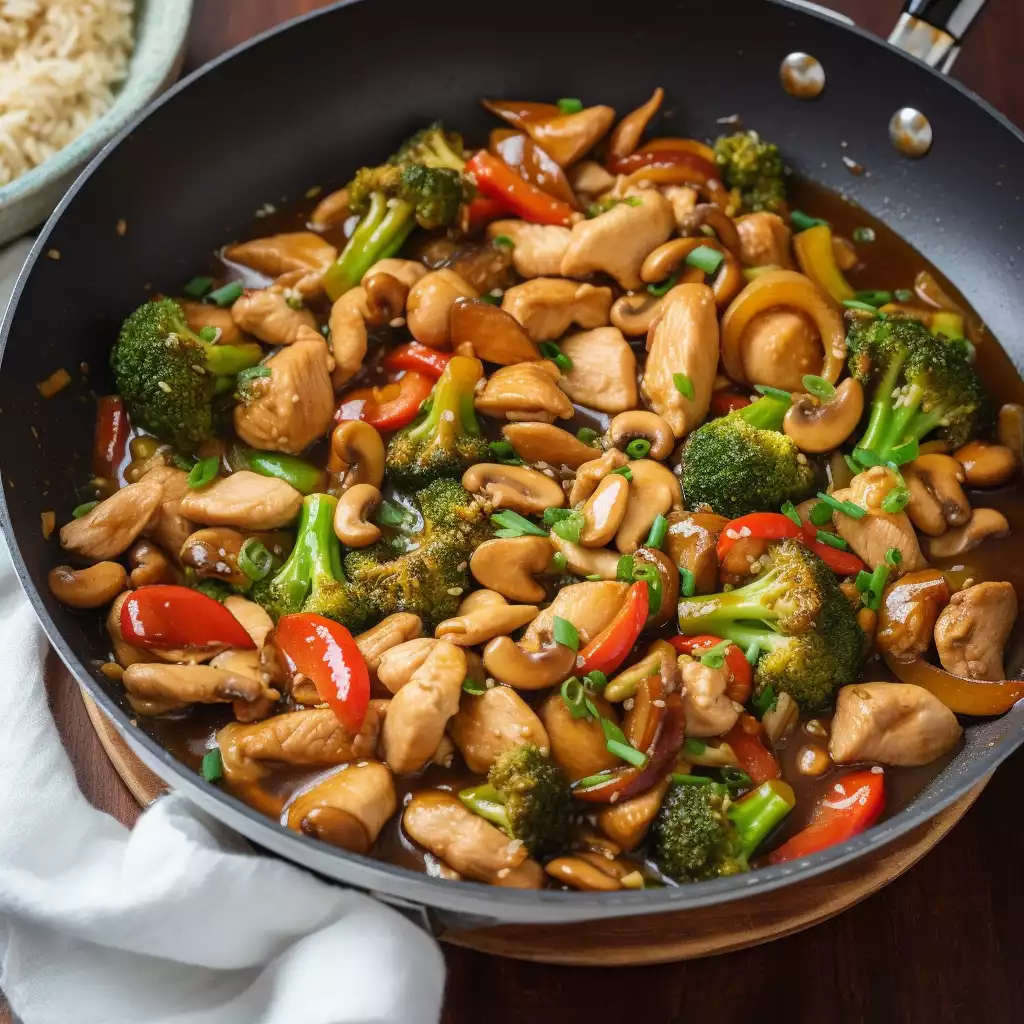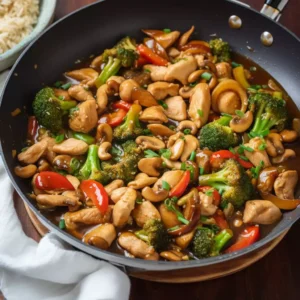
The Chicken Stir Fry is a culinary staple with roots deeply embedded in Asian cuisine, particularly Chinese cooking. This dish, known for its vibrant colours, crisp textures, and rich flavours, has journeyed through time and borders, adapting to various palates and kitchens around the world.
Originally, stir fry techniques emerged as a practical solution to cook food quickly, using little fuel, which was ideal in regions where resources were scarce.
The term ‘stir fry’ itself is a testament to the cooking method, where ingredients are stirred and fried rapidly over high heat in a wok. This technique not only conserves energy but also retains the freshness and nutrients of the ingredients.
The beauty of Chicken Stir Fry lies in its versatility. There’s no single fixed recipe, allowing cooks to adapt it according to available ingredients and personal preferences. From the bustling streets of Beijing to the cosy kitchens in the West, this dish has seen countless variations.
Whether it’s the addition of different vegetables like snow peas or carrots, or the infusion of various sauces from oyster to hoisin, each variation adds a unique twist to the classic recipe.
For beginners, Chicken Stir Fry is an excellent introduction to the world of cooking. It’s a dish that teaches the importance of preparation, timing, and balance of flavours.
The process of slicing the chicken, chopping the vegetables, and measuring out the sauce ingredients can be therapeutic and a great way to hone basic culinary skills. The actual cooking process is swift and rewarding, perfect for a quick yet satisfying meal.
The choice of ingredients in a Chicken Stir Fry also speaks volumes about its nutritional value. Chicken, a lean protein source, pairs beautifully with a variety of vegetables, each contributing its own set of vitamins and minerals.
Broccoli, for instance, is not only aesthetically pleasing with its vibrant green colour but is also a powerhouse of nutrients including vitamin C and dietary fibre. The red bell peppers add a sweet, almost smoky flavour, along with a healthy dose of vitamins A and C.
When it comes to sauces, the traditional mix of soy sauce, sesame oil, and a hint of sugar and corn-starch creates a perfectly balanced symphony of flavours. The soy sauce brings in umami and saltiness, while sesame oil adds a distinct nutty aroma.
The sugar, though used sparingly, rounds off the flavours with a subtle sweetness. This sauce, though simple, accentuates the natural flavours of the chicken and vegetables, creating a dish that’s harmonious in taste and texture.
Chicken Stir Fry is also a reflection of cultural fusion in culinary practices. As it travelled across continents, it adapted to local tastes and ingredients, creating variants like the Thai-inspired stir fry with basil and chili, or the teriyaki version popular in Japanese cuisine.
Each of these variations showcases the adaptability and global appeal of this humble yet flavourful dish.
Expert Tip: For the best Chicken Stir Fry, cut your chicken and veggies into uniform sizes. This ensures even cooking, so every bite is perfectly done.
Before diving into the specifics of each ingredient, let’s appreciate how they come together to create the delectable Chicken Stir Fry.
The beauty of this dish lies in its balance of flavours and textures, achieved through a thoughtful combination of protein, vegetables, and seasoning. Each ingredient plays a crucial role, bringing its own unique properties to the table.
Boneless Chicken Breast: The lean protein in chicken breast makes it ideal for a quick stir fry. It absorbs the flavours of the sauce beautifully while providing a substantial texture. For those looking for alternatives, tofu or shrimp can be excellent substitutes, catering to different dietary preferences while maintaining the integrity of the dish.
Broccoli Florets: Broccoli not only adds a vibrant green hue to the dish but also offers a delightful crunch. Its mild, earthy flavour complements the chicken well. If broccoli isn’t your thing or you’re looking to mix it up, try cauliflower or snap peas for a similar crunch and nutritional profile.
Red Bell Pepper: These peppers introduce a sweet and slightly tangy element, which contrasts nicely with the savoury chicken. The colour also adds visual appeal. Alternatives like yellow or orange bell peppers can be used for a similar sweet flavour and a different pop of colour.
Garlic: Garlic is essential for its aromatic quality, laying a flavourful foundation for the stir fry. It imparts a slightly spicy and earthy note. If garlic isn’t an option, shallots or a small amount of garlic powder can work as substitutes, though the flavour profile will slightly change.
Soy Sauce: Soy sauce brings depth with its salty and umami flavours. It acts as the backbone of the sauce, marrying well with the other components. For a gluten-free option, Tamari sauce is a perfect substitute. Another alternative is coconut aminos, which offer a sweeter, less salty flavour profile.
Sesame Oil: This oil adds a nutty and rich flavour, enhancing the overall taste of the stir fry. In its absence, a drizzle of peanut or olive oil can suffice, though the distinct sesame flavour will be missed.
Vegetable Oil: Used for its high smoke point and neutral flavour, it’s ideal for stir-frying at high temperatures. Canola or sunflower oil are good alternatives if vegetable oil is not available.
Fresh Ginger: Ginger introduces a warm, spicy kick that complements the chicken and vegetables. If fresh ginger is not at hand, ground ginger can be used in a pinch, but the fresh, zesty quality will be reduced.
Corn-starch: This is used to thicken the sauce, giving it a glossy, appealing texture. Arrowroot powder or tapioca starch are good alternatives for corn-starch, performing a similar function.
Sugar: A small amount of sugar balances the salty notes of the soy sauce. If you prefer to avoid sugar, a dash of honey or maple syrup can be used as a natural sweetener, adding a slightly different flavour.
Salt and Pepper: These seasonings adjust the overall flavour of the dish. They’re essential, but always added according to personal taste.
The Chicken Stir Fry is a harmonious blend of diverse ingredients, each contributing to the dish’s flavour, texture, and visual appeal. Understanding the role of each ingredient allows for flexibility and creativity in the kitchen, ensuring that this dish can be enjoyed in many delightful variations.
Expert Tip: Don’t overcrowd your pan or wok. Cooking in batches, if necessary, prevents steaming and achieves that desirable sear on the chicken and veggies.
Absolutely! You can prepare the components of the Chicken Stir Fry in advance. Cook the chicken and vegetables, then cool and store them separately in the fridge. The sauce can also be made ahead and refrigerated. Just before serving, reheat everything together in a pan. This method keeps everything fresh and tasty.
If you’re a fan of heat, you can easily spice up your Chicken Stir Fry. Add chopped chili peppers, red pepper flakes, or a splash of hot sauce to the stir fry. Start with a little and adjust according to your taste. The great thing about stir fry is its adaptability to different flavour preferences.
Chicken Stir Fry is traditionally served over a bed of steamed rice or noodles. These bases absorb the sauce beautifully and make the dish more filling. For a low-carb option, try serving it over cauliflower rice or zucchini noodles. Whichever way you choose, it’s sure to be delicious!
Yes, Chicken Stir Fry can be frozen, although the texture of the vegetables may change slightly upon thawing. To freeze, let the stir fry cool completely, then store it in an airtight container. It can be frozen for up to 3 months. When ready to eat, thaw it in the fridge overnight and reheat gently to maintain the best texture.
Certainly! Chicken Stir Fry is incredibly versatile. Feel free to add other vegetables like carrots, snap peas, mushrooms, or onions. This dish is a great way to use up any veggies you have on hand. Just remember to cut them into similar sizes for even cooking.
The key to tender chicken in a stir fry is not to overcook it. Cook the chicken pieces just until they are no longer pink inside. Another tip is to slice the chicken thinly and against the grain, which helps it stay tender during the quick cooking process.
No wok? No problem! You can use a large frying pan or skillet instead. Just make sure it has a high enough side to allow for easy stirring without spilling. The important part is to cook over high heat and keep the ingredients moving for that classic stir-fry texture.
Expert Tip: Always have all your ingredients prepped and ready before you start cooking. Stir frying is a fast process, and having everything at hand makes it smoother and prevents burning.
Here are some more recipes for you to enjoy! If you my recipes don’t forget to rate and leave a comment.
If you have any recipe suggestions, please do not hesitate to ask me. A great way to stay in contact with me is through Instagram, Facebook, Twitter and YouTube. Don’t forget to tag me @CookwithNabeela in your recipe photos!

Subscribe now to receive my latest recipes directly in your inbox. Stay up-to-date and never miss out!

I love to cook! I want to share with you my favourite, delicious family-friendly recipes. I want to inspire you to create fantastic food for your family every day.
Add your first comment to this post